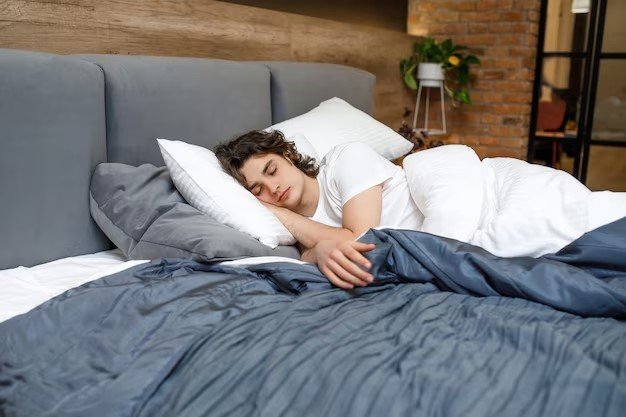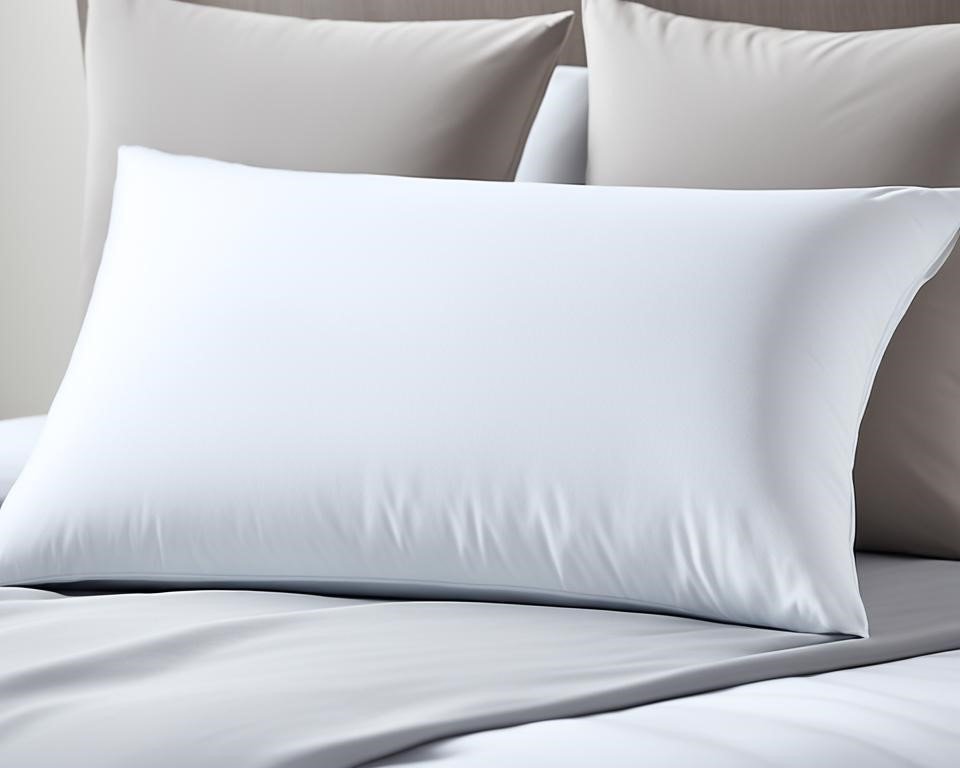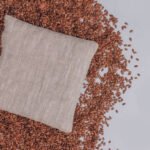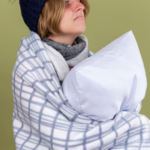Anti-allergy pillows Solutions are the key to a good night’s sleep for those who suffer from allergies. By finding suitable pillows, you can say goodbye to sneezing, congestion, and itchy eyes that keep you awake at night.
Many people with allergies struggle with sleep due to allergens in their bedding. But the right anti-allergy pillows can be the answer.
This guide will explore the best anti-allergy pillows solutions, delving into the differences between hypoallergenic and anti-allergy pillows. We’ll uncover which pillow materials help you breathe better and sleep well, even with allergies.

When picking the best pillow for allergies, consider the material, how breathable it is, and whether it resists dust mites and provides anti-allergy solutions . Natural materials like bamboo, latex, and memory foam are good for allergy-friendly sleep. Also, look for hypoallergenic covers and antimicrobial treatments to fight allergens.
Critical Points
- Anti-allergy pillows are designed to minimize exposure to common allergens like dust mites, pet dander, and mold.
- Hypoallergenic pillows are made with materials less likely to cause an allergic reaction, such as cotton, polyester, or synthetic foams.
- When choosing a pillow for allergies, consider the material, breathability, and dust mite resistance.
- Natural materials like bamboo, latex, and memory foam can provide a more allergy-friendly sleep environment.
- Features like hypoallergenic covers and antimicrobial treatments can further enhance a pillow’s ability to resist allergens.
Introduction to Anti-Allergy Pillows Solutions
Getting a good night’s sleep is vital to feeling great. One way to ensure this is by choosing hypoallergenic /anti-allergy pillows , which help reduce allergens in your bedding.
Why Anti-Allergy Pillows Matter
Pillows can contain allergens like dust mites, mold, and pet dander, which can worsen allergies and mess up sleep. Allergen-free bedding, including anti-allergy pillows, makes sleeping healthier. It leads to better sleep and overall health.
Common Allergens Found in Bedding
Many allergens can be found in bedding, causing discomfort and breathing problems. Common allergens in pillows and bedding are:
- Dust mites
- Mold and mildew
- Pet dander
- Pollen
- Feathers (in traditional pillows)
Knowing about these allergens can help you pick suitable anti-allergy pillows and allergen-free bedding, resulting in a better night’s sleep.
Understanding Hypoallergenic Pillows
Hypoallergenic pillows make sleeping safe and comfy for people with allergies or sensitivities. They use non-toxic materials to keep out allergens like dust mites, mold, and pet dander, making them great for creating an allergy-friendly sleep space.
These pillows are great at keeping dust mites away, which is good news for allergy sufferers. They use unique fabrics and fillings that stop these tiny pests from getting in. Plus, they’re made to fight mold and mildew, making them perfect for people with allergies.
- Minimizes exposure to common allergens like dust mites, mold, and pet dander
- Utilises non-toxic pillow materials to create an allergy-friendly sleep environment
- Provides a barrier against the accumulation of dust mites and other irritants
- Resistant to mold and mildew growth for improved indoor air quality
Adding hypoallergenic pillows to your bed can make sleeping much better for those with allergies. You’ll get a good night’s sleep without the usual symptoms from regular pillows. These pillows are a natural and effective way to make your sleep space healthier and allergy-friendly.
“Hypoallergenic pillows have been a game-changer for me. I no longer wake up with stuffy nose and watery eyes, and I feel so much more rested and energized in the morning.”
– Sarah, a satisfied customer with allergies
Dust Mite Resistant Pillows
Allergies can make sleeping hard. Dust mite-resistant pillows offer a solution. These pillows are made to keep dust mites away, which can cause sneezing, coughing, and watery eyes. They help allergy sufferers sleep better and more comfortably.
Benefits of Dust Mite Resistant Bedding
Buying dust mite-resistant bedding, like pillows, helps those with allergies. These products keep dust mites away, reducing allergy symptoms. This means less congestion, itching, and better sleep, leading to more energy during the day.
Materials Used in Dust Mite Resistant Pillows
- Microfiber – Microfiber’s tight weave keeps dust mites out while being soft and breathable.
- Bamboo – Bamboo’s natural fight against germs makes it great for pillows, offering comfort and allergy relief.
- Synthetic Fills – Materials like polyester or memory foam can stop dust mites, offering a hypoallergenic choice.
Choosing the right dust mite-resistant pillow means examining the materials and how well they block allergens. By picking these pillows, allergy sufferers can sleep better and wake up feeling refreshed.
| Material | Dust Mite Resistance | Breathability | Comfort |
| Microfiber | High | High | Moderate |
| Bamboo | High | High | High |
| Synthetic Fills | Moderate | Moderate | High |
Anti-Allergy Pillows Solutions
Anti-Allergy Pillows Solutions are perfect for those seeking an allergy-friendly sleep environment.
Anti-allergy pillows are designed to be both comfortable and allergen-proof, reducing symptoms caused by allergens in regular pillows.
Our Anti-Allergy Pillows Solutions excel at keeping dust mites away, using unique materials and designs to block these allergens.
This means a cleaner and healthier place to sleep with our Anti-Allergy Pillows Solutions.
- Hypoallergenic materials like memory foam or microfiber can help create an allergen-proof sleep surface.
- Breathable and moisture-wicking fabrics promote airflow, keeping the sleeping area fresh and comfortable.
- Zippered encasements or removable covers allow for easy cleaning, further enhancing the anti-allergy properties of the pillows.
Some anti-allergy pillows also fight mold, mildew, and pet dander. These pillows are critical to an allergy-friendly sleep environment and help people with allergies get a good night’s sleep.
“Investing in high-quality anti-allergy pillow solutions can make a significant difference in the quality of life for those struggling with allergies.”

Adding anti-allergy pillows to your bed can make sleeping better for people with allergies. These pillows are a simple yet effective way to make your sleep area healthier and allergen-proof.
Breathable and Soft Pillows for Allergies
For people with allergies and sensitive skin, picking the right pillow is vital to a good night’s sleep. Anti-allergy pillows must be made of breathable and soft materials.
Importance of Breathability
Breathable pillow covers are vital for keeping air moving and stopping heat and moisture from building up, which can make allergy symptoms worse. They also keep the temperature correct and make sleeping comfy, reducing skin irritation and breathing problems.
Soft and Gentle Materials for Sensitive Skin
Anti-allergy pillows use soft and gentle materials like hypoallergenic cotton, bamboo, or microfiber. These allergy relief products are easy on the skin. They help avoid irritation or allergic reactions.
| Material | Hypoallergenic | Breathability | Softness |
| Cotton | Yes | High | Soft |
| Bamboo | Yes | High | Soft |
| Microfiber | Yes | Moderate | Very Soft |
Anti-allergy pillows focus on breathability and use soft and gentle materials for sensitive skin. This helps relieve and comfort those with allergies or skin sensitivities.
Allergen-Free Bedding Solutions
Creating a truly allergy-friendly sleep environment starts with high-quality, allergen-free bedding. Products like hypoallergenic pillowcases and mattress protectors can greatly improve air quality and reduce exposure to common allergens like dust mites, mold, and pet dander.
Benefits of Allergen-Free Bedding
Using allergen-free bedding in your sleep setup offers many benefits. These include better respiratory health and more restful sleep. Some key advantages are:
- Reduced exposure to dust mites, a leading trigger for allergy and asthma symptoms
- Improved air circulation and breathability for a more allergy-friendly sleep environment
- Minimized risk of mold and mildew growth, which can worsen allergies
- Protection against pet dander and other common household allergens
- Hypoallergenic materials that are gentle on sensitive skin
Choosing natural allergy remedies like allergen-free bedding can change the game. It makes sleeping healthier and more comfortable.
| Feature | Benefit |
| Dust Mite Resistance | Reduces exposure to a leading allergy trigger |
| Breathable, Moisture-Wicking Fabrics | Promotes air circulation and prevents mold/mildew growth |
| Hypoallergenic Materials | Gentle on sensitive skin and eyes |
| Protection from Pet Dander | Minimizes another common household allergen |

“Investing in high-quality, allergen-free bedding can significantly improve your allergy-friendly sleep environment. It provides natural relief from a variety of respiratory issues.”
Natural and Eco-Friendly Anti-Allergy Pillow Options
Eco-friendly pillow options are changing the game for people with allergies. Made from natural materials like organic cotton, bamboo, and latex, they’re a fresh choice compared to traditional pillows. These pillows don’t have harmful allergens.
Organic cotton pillows are breathable and don’t have synthetic chemicals. Bamboo pillows have natural antibacterial and moisture-wicking properties. Latex pillows, made from rubber tree sap, are durable and keep away dust mites and allergens.
- Organic cotton pillows: Breathable and hypoallergenic
- Bamboo pillows: Antibacterial and moisture-wicking
- Latex pillows: Dust mite-resistant and long-lasting
These eco-friendly pillow options help those with allergies and support a sustainable sleep. Choosing natural allergy remedies like these means a peaceful night’s sleep. You won’t have to worry about non-toxic pillow materials making you feel bad.
“Investing in an eco-friendly, anti-allergy pillow can be a game-changer for those who struggle with allergies. It’s a simple yet effective way to create a healthier sleep environment.”
Caring for Anti-Allergy Pillows
Keeping your anti-allergy pillows in good shape is key to a healthy sleep. Wash them regularly and store them properly. This helps keep your pillows working well, relieving allergies all night.
Washing and Maintenance Tips
Experts say to wash your anti-allergy pillows every 2-3 months. Use a gentle, hypoallergenic detergent. Don’t use fabric softeners or bleach; they can harm the pillows’ ability to block allergens. Dry them on a low heat setting to avoid damage.
Check your pillows often for any signs of wear or damage. Replace them if needed to keep them working well. This ensures they keep protecting you from allergens.
Storing your pillows right is also crucial. Keep them in an excellent, dry spot, away from sunlight or moisture. Use bags or containers that let air in to stop dust and allergens from building up. By following these tips, your anti-allergy pillows will continue to give you a good night’s sleep, free from allergies.
FAQs
What are the benefits of using anti-allergy pillows?
Anti-allergy pillows improve sleep for people with allergies and sensitivities. They keep out allergens like dust mites, mold, and pet dander, helping to avoid allergy symptoms and improve sleep quality.
What materials are used in hypoallergenic pillows?
Hypoallergenic pillows are made from microfiber, memory foam, latex, or bamboo. These materials are good at keeping out allergens and are easy to clean. They make sleeping more comfortable and breathable for those with allergies.
How do dust mite-resistant pillows work?
Dust mite-resistant pillows have unique fabrics and designs that stop dust mites from living there. They often have tightly woven covers or use materials like microfiber. This creates a barrier against dust mites, offering allergy relief.
What are the benefits of allergen-free bedding solutions?
Allergen-free bedding, like hypoallergenic pillowcases and mattress protectors, makes sleeping more allergy-friendly. It reduces exposure to common allergens. This can lead to better sleep, fewer allergy symptoms, and improved health.
What are some eco-friendly and natural anti-allergy pillow options?
Eco-friendly and natural anti-allergy pillows are made from organic cotton, bamboo, or latex. These materials are hypoallergenic, breathable, and free from harsh chemicals. They offer a sustainable and non-toxic choice for those with allergies and sensitivities.
How should I care for my anti-allergy pillows?
Taking good care of anti-allergy pillows is critical to their effectiveness. As the maker says, wash them and their covers using hot water and mild soap. Let them air dry. Also, store and rotate them properly to make them last longer.
More to Explore:
Anti-Allergy Pillows Aromatherapy Pillows Meditation Pillows
Child and Baby Pillows Bamboo Pillows Natural Latex Pillows
Organic Cotton Pillows Recycled Material Pillows Pillow Inserts
















